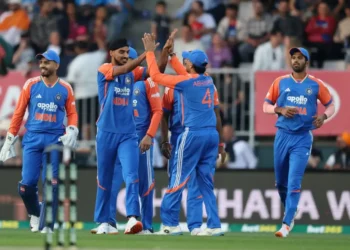In modern T20 cricket, India faces a strange dilemma — too many good bowlers, but not enough room for them all. Arshdeep Singh knows that challenge better than anyone. He is India’s highest wicket-taker in T20Is, yet often watches from the sidelines when team balance demands more batting depth.
But when given a chance, he reminds everyone why he cannot be ignored. Against Australia, Arshdeep returned with rhythm, swing, and precision. His three wickets — including Travis Head and Josh Inglis — set the tone for India’s victory. He combined control and aggression, proving why he remains India’s most impactful left-arm pacer in the shortest format.
This comeback was not just about wickets. It was a statement — a message that India’s best strike bowler is ready for any condition, any opponent, and any stage. His ability to move the new ball and close at the death makes him unique in a squad stacked with right-arm quicks.
While selection debates continue around India’s batting-heavy combinations, Arshdeep’s performance forces a rethink. When the ball swings and pressure mounts, there’s only one name India turns to — Arshdeep Singh.
The selection dilemma — India’s search for perfect T20 balance
India’s biggest strength in T20Is has become its toughest challenge — balancing world-class bowlers with sufficient batting depth. With Jasprit Bumrah, Mohammed Siraj, Arshdeep Singh, and Kuldeep Yadav available, the attack looks lethal. But none of them offer consistent runs down the order.
This limitation often pushes India to bench one of their best. Arshdeep, despite being the team’s highest wicket-taker, missed key games in the Asia Cup and the first two matches in Australia. It’s a tactical compromise — one that often hurts the bowling impact.
In conditions like early-season Australia, where swing and seam matter, Arshdeep’s exclusion surprised many. When finally brought in, he changed the match instantly. His new-ball spell reduced Australia to 24 for 2 in four overs. He and Bumrah together strangled the chase and controlled the powerplay.
This game again exposed India’s balancing act — picking Washington Sundar for batting insurance but not bowling him at all. Such decisions leave gaps that impact bowling continuity. Arshdeep’s inclusion showed the value of attacking intent and how one bowler’s rhythm can change the entire match flow.
T20 cricket is built on compromise. Teams chase all-round balance but often sacrifice specialists. India’s strength in depth sometimes hides its real issue — the absence of bowling depth when too many batters play. Arshdeep’s spell reminded everyone that wickets win matches, not tail-end runs.
How Arshdeep’s three wickets defined his comeback?
Arshdeep’s return was not about numbers alone; it was about timing and impact. He removed Travis Head early with a late-swinging delivery that clipped the edge. Moments later, Josh Inglis fell to another ball that seamed away beautifully. These wickets came during the crucial powerplay, where momentum defines the rest of the innings.
His third wicket came at the death, a phase where he often thrives. Partnering with Bumrah, he denied Australia any late flourish. Every over was measured — mixing yorkers, bouncers, and slower balls to perfection.
For a bowler who had waited patiently for opportunities, this was a perfect reply. His control under pressure reflected preparation, not luck. Arshdeep showed how rhythm, accuracy, and mental calm matter more than raw pace in modern T20 cricket.
The psychological comeback that stood out
Comebacks test more than skill; they test resilience. Arshdeep didn’t just bowl overs — he made a statement. Every wicket told a story of patience rewarded. For a young fast bowler, staying mentally ready despite selection gaps takes character. That’s what separates him from the rest.
How Arshdeep is the perfect T20 bowler — skill, swing, and mindset?
Arshdeep’s bowling suits every element of T20 strategy. He swings the new ball both ways, hits the right lengths, and adjusts to conditions instantly. His high-arm release creates bounce even on slow pitches, while his cutters deceive batters at the death.
Unlike traditional power bowlers, he values control more than speed. His strike rate ranks only behind Kuldeep Yadav among Indian bowlers with 50+ T20I wickets. That consistency makes him a captain’s dream. In Australia, where bounce and seam reward precision, Arshdeep was unplayable in the first spell.
He’s also evolved into a thinker — setting traps, reading batters, and manipulating angles. That maturity comes from IPL experiences with Punjab Kings, where he learned to defend impossible totals. In India’s setup, he complements Bumrah’s explosiveness with left-arm variety and swing. Together, they form one of the most dangerous new-ball pairs in world cricket.
The new template for modern fast bowlers
The T20 bowler of the future isn’t just fast; he’s smart. Arshdeep fits that mould — a blend of accuracy, awareness, and adaptability. His success proves that India’s pace future lies in balance — brains as much as brawn.
How Arshdeep made an impact beyond wickets?
Arshdeep’s influence went beyond his three dismissals. His early overs built pressure that forced errors from other batters. Australia scored only 24 in the first four overs — a crucial deficit that India capitalized on while chasing. His control allowed Bumrah to attack more freely at the other end.
He also contributed strategically. Knowing Australia’s middle order was right-handed, Arshdeep angled deliveries away to restrict room. It forced mistakes and broke partnerships. His death overs contained yorkers that neutralized finishers like Tim David and Matthew Wade.
This isn’t just impact; it’s leadership through performance. When bowlers around him looked tired, he stayed disciplined. That kind of influence shapes the team’s rhythm, especially in fast-paced T20s.
Not every impact is visible on scoreboards. Arshdeep’s spells tighten games by denying momentum. His quiet efficiency makes him indispensable — the kind of bowler who doesn’t need headlines to change results.
The takeaway — India’s missing piece might already be here
India’s T20 team doesn’t lack talent; it needs trust. Arshdeep’s performance should end the constant debate over selection balance. His bowling brings control, his temperament brings calm, and his left-arm angle brings variety.
The team management must find a way to include him consistently. Whether paired with Bumrah or backed by spin depth, Arshdeep’s presence completes India’s bowling puzzle. His improvement under pressure shows he’s more than a supporting act — he’s a match-winner in his own right.
If India builds around his strengths, the balance will come naturally. Sometimes, the missing piece isn’t new — it’s the one already waiting patiently on the bench.
Team India’s next challenge is simple — back specialists even in short formats. Arshdeep’s comeback proves that clarity and faith produce results. India must use that blueprint to fix its T20 imbalance and reclaim consistency worldwide.
Conclusion
Arshdeep Singh’s comeback highlights what India has been missing — fearless intent and left-arm rhythm. His three wickets reminded everyone why genuine wicket-takers can’t sit out due to team balance alone.
The left-armer continues to grow as India’s most reliable T20 weapon. His swing, seam, and calm under pressure bring balance to a team often overloaded with batters. In a sport obsessed with all-rounders, Arshdeep shows the value of specialists who can deliver magic in six balls.
His spell against Australia was more than a performance — it was proof. Proof that India’s fast-bowling depth can dominate anywhere if selection reflects clarity, not compromise.
As the T20 cycle moves toward bigger tournaments, Arshdeep’s name should no longer be debated. He’s not just an option; he’s essential. The message from his comeback is clear — sometimes, the player who waits quietly makes the loudest statement when called.














